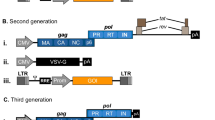Abstract
Lentiviral-mediated transfection technique is a powerful tool for gene modification in preclinical studies. By using this technique, the desired gene modification can be achieved easily in immune cells, nondividing, and terminally differentiated cells, including hematopoietic stem cells, neurons, and even tumor cells, which other viral vectors cannot do. The main considerations of therapeutic gene delivery using a lentiviral system are the risk of insertional mutagenesis and the immune reaction elicited by infected cells. Although some biosafety concerns need to be addressed before clinical trials in rheumatoid arthritis, the lentiviral system targeting therapeutic targets has been widely used for in vivo gene transfer in animal models. In this chapter, the protocols for production of viral particles and viral concentration are provided. As an alternative utilization, this lentiviral production platform could also be employed to produce a pseudotype severe acute respiratory syndrome-related coronavirus 2 in which the spike glycoprotein of SARS-CoV-2 was incorporated into pseudovirions for viral study.
Access this chapter
Tax calculation will be finalised at checkout
Purchases are for personal use only
Similar content being viewed by others
References
Evans CH, Ghivizzani SC, Robbins PD (2011) Getting arthritis gene therapy into the clinic. Nat Rev Rheumatol 7:244–249
Liu S, Maeyama K (2016) Gene therapy for rheumatoid arthritis. Crit Rev Immunol 36:149–161
Buchschacher GL Jr, Wong-Staal F (2000) Development of lentiviral vectors for gene therapy for human diseases. Blood 95:2499–2504
Lewis PF, Emerman M (1994) Passage through mitosis is required for oncoretroviruses but not for the human immunodeficiency virus. J Virol 68:510–516
Liu S, Kiyoi T, Takemasa E, Maeyama K (2017) Intra-articular lentivirus-mediated gene therapy targeting CRACM1 for the treatment of collagen-induced arthritis. J Pharmacol Sci 133:130–138
Liu S, Kiyoi T, Takemasa E, Maeyama K (2015) Systemic lentivirus-mediated delivery of short hairpin RNA targeting calcium release-activated calcium channel 3 as gene therapy for collagen-induced arthritis. J Immunol 194:76–83
Liu S, Watanabe S, Shudou M, Kuno M, Miura H, Maeyama K (2014) Upregulation of store-operated Ca entry in the naive CD4 T cells with aberrant cytokine releasing in active rheumatoid arthritis. Immunol Cell Biol 92:752
Cavazzana M, Six E, Lagresle-Peyrou C, Andre-Schmutz I, Hacein-Bey-Abina S (2016) Gene therapy for X-linked severe combined immunodeficiency: where do we stand? Hum Gene Ther 27:108–116
Ott MG, Seger R, Stein S, Siler U, Hoelzer D, Grez M (2007) Advances in the treatment of chronic granulomatous disease by gene therapy. Curr Gene Ther 7:155–161
Stein S, Ott MG, Schultze-Strasser S, Jauch A, Burwinkel B, Kinner A et al (2010) Genomic instability and myelodysplasia with monosomy 7 consequent to EVI1 activation after gene therapy for chronic granulomatous disease. Nat Med 16:198–204
Marshall E (1999) Gene therapy death prompts review of adenovirus vector. Science 286:2244–2245
Liu S, Suzuki Y, Takemasa E, Watanabe R, Mogi M (2022) Mast cells promote viral entry of SARS-CoV-2 via formation of chymase/spike protein complex. Eur J Pharmacol 930:175169
Ou X, Liu Y, Lei X, Li P, Mi D, Ren L et al (2020) Characterization of spike glycoprotein of SARS-CoV-2 on virus entry and its immune cross-reactivity with SARS-CoV. Nat Commun 11:1620
Author information
Authors and Affiliations
Corresponding author
Editor information
Editors and Affiliations
Rights and permissions
Copyright information
© 2024 The Author(s), under exclusive license to Springer Science+Business Media, LLC, part of Springer Nature
About this protocol
Cite this protocol
Liu, S. (2024). Lentiviral Production Platform. In: Liu, S. (eds) Rheumatoid Arthritis. Methods in Molecular Biology, vol 2766. Humana, New York, NY. https://doi.org/10.1007/978-1-0716-3682-4_17
Download citation
DOI: https://doi.org/10.1007/978-1-0716-3682-4_17
Published:
Publisher Name: Humana, New York, NY
Print ISBN: 978-1-0716-3681-7
Online ISBN: 978-1-0716-3682-4
eBook Packages: Springer Protocols




